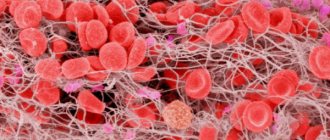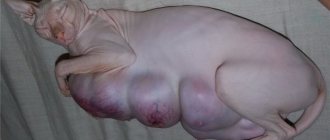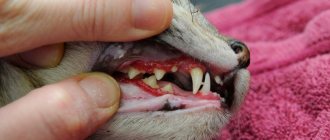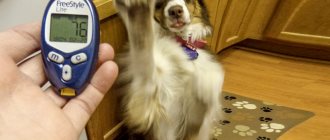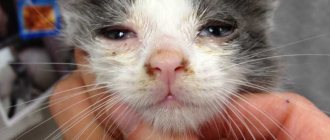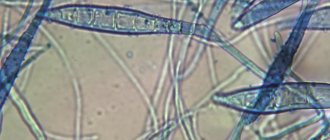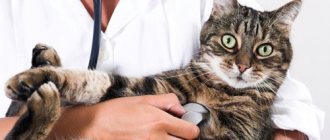An abscess in domestic cats and cats, accompanied by the appearance of purulent wounds, is rare. Stay-at-home pets rarely suffer serious injuries, but such situations should not be ruled out. The resulting abscess can lead to blood poisoning. Therefore, it is very important to recognize it before serious complications occur and to be able to provide first aid if an emergency visit to the veterinarian is not possible.
Causes of abscess in cats
The inflammatory process in animal tissues occurs as a result of the following factors and causes:
- Injuries, mechanical damage. Violation of the integrity of the skin with infection occurs as a result of bites from fellow animals or dogs. The oral cavity of animals contains a huge number of pathogenic microorganisms, and when bitten, the microbes penetrate deeply into the soft tissues.
In case of injuries of various origins (collisions by road vehicles, blows with a piercing object, falls from a height, splinters, etc.), extensive damage to the skin occurs, penetration of pathogenic microorganisms into the deep layers.
An abscess of the oral mucosa often occurs due to injury from sharp bones or foreign objects. The inflammatory process on the extremities often occurs as a result of a splinter, a thorn from a plant, glass, or a sharp object getting into the crumb of the paw. An abscess can also develop if the animal is infected with fleas and lice, or if there is an allergic reaction. Itchy skin encourages your pet to scratch vigorously, damaging the skin with its claws.
- Dental problems. A broken tooth, carious processes, and periodontal disease are the main causes of odontogenic abscesses in domestic cats.
- Violation of the rules of asepsis and antisepsis when performing intramuscular or subcutaneous injections.
- Suppuration of hematomas, lymphatic extravasations resulting from injuries.
- The cause of the development of purulent infection in the anal area is the inflammatory process of the paraanal glands. The owner does not immediately detect the symptoms of the pathology, as a result of which an abscess often develops in this area.
Predisposing factors in the etiology of purulent inflammation are weakened immunity, the presence of concomitant diseases, and the advanced age of the pet. Keeping animals in premises that are unsatisfactory in terms of sanitary conditions also leads to the development of suppuration due to microtraumas of the skin.
What symptoms does it cause when it appears on a cat?
A cat usually gets skin damage outside the home, on the street.
A walking animal can be attacked by its relatives, this especially often happens during periods of sexual hunting, as well as when territorial claims are being clarified. In this case, both males fighting for females and cats zealously guarding their possessions suffer. The wounds inflicted by the enemy are varied. When fighting, animals use sharp claws, as well as equally dangerous teeth. If the pet is involved in a cat fight, then the nature of the injury is often observed in the form of scratches, bites and lacerations. Bite wounds are considered the most dangerous due to the penetration of infection into the deep layers of skin and muscle tissue.
Their eternal enemies – dogs – can attack a pet and cause serious damage. In this case, the wounds will in most cases be lacerated, and will also be
teeth marks are visible on the skin.
Often, gullible domestic cats become victims of cruel people. The instruments of crime can be various objects, the nature of the wound can be punctured, torn, or bruised. In rare cases, owners may also experience gunshot wounds.
Dangerous injuries can be caused to animals by falling from a height or being run over by vehicles. Such wounds are usually crushed and bruised.
Pets get deep cuts to their limbs when they come into contact with sharp metal and glass objects. In this case, the owner will be dealing with a cut or laceration. Often, pets are found to have a mixed wound - a poisoned wound when a toxic substance comes into contact with the wound surface. This type of damage is typical when bitten by poisonous snakes, insects, or when chemicals get into the wound.
At home, a furry couch potato can become a victim of domestic trauma, for example, when sharp objects fall from a height. Self-injury is a common cause of skin damage. This phenomenon is observed when combing and gnawing the pathological focus. A separate type of violation of the integrity of the skin is postoperative wounds.
For any reason that a pet is injured, the owner faces the problem of how to treat the cat’s wound at home.
In most cases, abscesses in cats occur as a result of damage to the integrity of the skin, after various injuries that purrs can receive, for example, during a fight. A cat bite is considered one of the most “dirty” injuries, leading to the development of abscesses and ulcers.
Depending on the nature, depth of the cuts, and the speed of wound healing, as the damaged areas of the skin heal, they “cover” bacteria and pathogenic flora, as a result of which a pathogenic inflammatory process develops. White blood cell structures of the blood, leukocytes, as well as lymphocytes, neutrophils are sent to the infected area.
An abscess or abscess can develop after an incorrectly administered intramuscular or subcutaneous injection if the rules of asepsis and antisepsis are not followed by a veterinarian or owner.
Animals kept in unfavorable conditions and cats with a weakened immune system and body resistance are at risk. With strong immunity, the body is able to cope with infection and wound healing occurs without any pathological consequences.
The most common cause of an abscess is mechanical damage. When bitten or scratched, an infection enters the wound, which can develop into an abscess. Cats get injured during fights, the most common places are the face and back. An animal can get a splinter on its paw, where, in the absence of access and suppuration of a foreign agent, inflammation can develop.
It is not uncommon for abscesses to develop at the injection site if antiseptic rules are neglected. Suppuration also occurs in the oral cavity, due to damage to the mucous membrane from small bones or their fragments, especially if the cat likes to eat from the trash can.
Odontogenic abscesses are possible due to carious lesions of teeth, as well as from a broken tooth. Suppuration develops in the area of the tooth root and dangerously involves the jaw bone in the process.
Abscess of the perianal region - when the glands of the paraanal gland become inflamed, an abscess may appear. These glands are responsible for marking the cat's territory; when they are affected, the cat emits an unpleasant odor and constantly licks the sore spot. The animal constantly meows in pain, and problems begin with going to the litter box.
Treating wounds on the animal's body in a timely manner will help prevent the development of a purulent process.
The following symptoms are typical for an abscess in cats:
- Hemispherical shape.
- The cat experiences pain when trying to touch the abscess.
- Fluctuation.
- The temperature of the area where the abscess occurred is increased. It is possible that the entire body temperature will be elevated.
- Frequent pulse.
- Rapid breathing.
- Apathetic and depressed state of the pet.
All of the above symptoms are characteristic of a hot abscess, which occurs during acute inflammation. Separately, it is worth noting such a type of abscess as cold ulcers.
The thing is that during their formation and maturation the temperature does not rise, there is no pain or redness. That is, they are not accompanied by inflammation.
Cold abscesses in cats are extremely rare. They are usually formed during tuberculosis of the skin, bones, and joints.
When the abscess has not yet become very aggravated, you can apply lotions. For example, vinegar is diluted with water and a lotion is made. You can make warming compresses, heating pads, and various poultices.
After the abscess opens, it needs to be washed out of pus. This is done with a weak solution of potassium permanganate. If your cat develops a fever after this, you should see a veterinarian.
Treatment is carried out using the drug traumeel. This is the most appropriate choice for abscesses. Under the influence of this drug, the abscess quickly matures and comes out.
This drug also copes with the temperature and pain that are characteristic of these abscesses during the process of their formation.
If the cat has several abscesses, Echinacea compositum will help. It is done by injection. First, on the very first day, you should make 2 injections, and then once every day until recovery occurs.
An abscess occurs due to the introduction of bacterial microflora into the wound. When the skin is restored, pus accumulates under it, and there is no outflow. This problem occurs in cats and kittens, but most often in cats, which quite often start fights among themselves. The most common cause of a purulent abscess is infection of wounds resulting from fights with other animals. Since cats have a lot of microbes on their nails, the wound received from them becomes infected immediately.
We invite you to read: Reconstructions of vertebrates [1988 -
Other causes of subcutaneous suppuration:
- Damage to the mucous membranes in the animal's mouth by fish bones. Particularly dangerous are old rotten remains, which harbor a large number of pathogenic microorganisms;
- Damage to the skin of a cat by a bird or other animal;
- Injection with an infected syringe;
- Subcutaneous administration of a drug that is poorly absorbed;
- Damage to the mucous membranes from a chipped tooth or suppuration of the tooth root;
- Injury to the paws from a thorn or thorn.
Abscesses in cats can occur several times throughout their lives, so the owner needs to be able to distinguish between this problem. In the early stages, the disease responds well to treatment, which means it is important to contact a veterinarian in a timely manner without waiting for your pet’s condition to worsen.
Do I need to open the abscess?
The abscess is opened in all cases, unless the lump has burst on its own and has not yet had time to fully form. If you do not give the pus a chance to come out, it will begin to spread to nearby tissues.
You should not try to open an abscess yourself at home. The inability to anesthetize a pet, failure to comply with the rules of asepsis and antiseptics, and unprofessional actions can lead to serious consequences for the health of a four-legged pet and even cause its death.
Breeds prone to boils
Veterinary specialists and experienced breeders have not found a pattern in the breed's predisposition to the formation of abscesses.
However, there is a group of animals prone to developing purulent inflammation on the skin. First of all, these are uncastrated males and unsterilized females.
Cats that fight during the heat period are especially prone to abscesses of the face and neck. Unsterilized cats also defend their territory and suffer battle wounds.
If there are several animals in the house, then from time to time there may be clashes between them. A native cat most often defends its territory from a new neighbor and can injure the new resident.
Young and active animals are more often susceptible to all kinds of bruises and mechanical damage, in contrast to older pets leading a sedentary lifestyle. And, of course, cats that roam freely on the street are also at risk compared to domestic couch potatoes.
The diet of a cat with purulent wounds also affects the treatment of purulent wounds in cats
A cat with festering wounds is very sensitive
.
All smoked meats, sausages, sweets that should not be given to even healthy cats, and fatty meats should be removed from the diet. A festering wound will heal faster if you eat healthy, natural foods, for example, vegetables, boiled chicken, and fish. Remember healthy, dietary food in hospitals and sanatoriums. You will never find sausage or unhealthy smoked brisket there. During the period of active recovery, it is very advisable to give your pet synthetic vitamins that will help maintain the health of the furry.
Prevention
Since the most common cause of abscesses is injuries after a fight, the main preventative measures are to limit the cat’s free movement on the street. Sterilization and castration reduce the animal's aggressiveness and the frequency of fights. Therefore, if access to the street is impossible, this will be a good prevention.
READ Siberian tortoiseshell cat
You should not allow your animal to eat from a garbage can, or give leftovers from your table containing small fish bones. Be sure to treat wounds and abrasions and carefully examine your pet after a walk for bites and splinters.
To prevent abscesses of the paraanal glands, especially in cats with long hair, they should be cleaned of accumulated secretions. It is not recommended to carry out this procedure at home, as it can be painful for your pet and cause outbursts of aggressive behavior. It is better to leave this method to a specialist.
The main preventive measure that will protect against the appearance of a purulent abscess in a pet is to limit movement on the street and contact with other animals. If it is not possible to control the cat on walks, you should reduce its aggressiveness by castration or sterilization.
It is necessary to ensure that the animal does not eat from a trash can or garbage can, where the remains of small fish bones can be found. You should carefully examine your pet’s body for wounds or abrasions, and if there are any, treat them until they are completely healed.
To prevent abscess of the paraanal glands in a cat, they should be systematically cleaned of the accumulation of secretions. It is best to entrust cleaning to a specialist, since an untrained person can cause pain to the pet and cause an aggressive reaction.
Cats at risk for abscess
I would like to emphasize that owners of neutered pets practically do not encounter such a phenomenon as an abscess. Sterilized animals spend little time walking, do not get involved in conflicts, and therefore are less exposed to danger. Those who are adopting a cat should think about this.
Animals are most at risk of becoming infected when:
- They spend a lot of time outside uncontrollably.
- Your pet is a cat. Males are bigger bullies than females, so they hurt them more often.
- The pet is at the peak of sexual maturity (from 1 year to 7-8 years). In this age group, fighting is common.
- Cats with weak immunity and poor health.
- A new four-legged resident has appeared in the house. Dividing up territory and challenging rights between pets will lead to a showdown between pets. Battle wounds are inevitable.
Complications that may occur
The insidiousness of the inflammatory process in tissues lies in the development of various kinds of complications. The most common consequence of an abscess is cellulitis. This occurs when inflammation spreads to the subcutaneous fat due to a weak immune system of the body or when an anaerobic infection develops.
Abscess of the paraanal glands in domestic cats is fraught with the development of fistulas and septic processes that threaten life.
A localized inflammatory process in the oral cavity is accompanied by refusal of food and the development of cachexia.
An abscess of any location and nature with an ineffective immune system, a weakened body due to a concomitant disease, can lead to the transition of the pathological process to deep-lying tissues.
Often, not only the skin, but also cartilage, joints, and internal organs become inflamed. A dangerous complication of an abscess is sepsis.
There is reliable information that in cats that often suffer from purulent infections, the risk of developing immunodeficiency of viral etiology increases.
Knowing the possible complications of even a small abscess on the skin, the owner must pay close attention to the disease and provide the pet with professional help.
How does the disease manifest?
The symptoms of this disease are determined by general and characteristic features. A sick pet already in the first 2-3 days loses interest in active games, walks, and loses appetite.
Common symptoms are:
- increased heart rate;
- increased breathing;
- apathy;
- oppression;
- sluggish gait;
- increase in body temperature by 1-2 degrees;
- signs of pain.
Based on such signs, it is extremely difficult to guess the presence of an abscess - they appear in dozens of diseases. Even an experienced veterinarian will rely on characteristic signs when making a diagnosis:
- the appearance of a tumor in the form of an even or asymmetrical hemisphere;
- a feeling of fluctuation when palpating the abscess - a transfusion of fluid is felt inside it;
- pain when pressing on the tumor;
- baldness at the site of the abscess;
- presence of a bite, puncture or penetrating injury;
- increased local temperature at the site of pus formation;
- the appearance of wet sticky discharge on the fur at the site of swelling;
- the appearance of unpleasant odors characteristic of rotting flesh;
- the appearance of scabs at the site of the abscess and near it.
Characteristic signs also include symptoms characteristic of abscesses with a specific location.
When the paws are affected, there is lameness, decreased activity, and the cat begins to be wary of stepping on the affected paw.
With an abscess of the paraanal glands, a small lump-like growth near the anus becomes noticeable.
The periodontal type of abscess is accompanied by a sharp refusal to feed, the appearance of bad breath, and the pet mainly drinks only water.
With an ear abscess, especially if it is caused by the activity of a tick, the ear sag, the animal constantly scratches it with its paw, makes rotating or nodding movements with its head.
However, despite the obviousness of the characteristic signs of an abscess in cats or male cats, animal owners should not make their own diagnosis based on the identified symptoms. They may be similar to the signs of other diseases, and then a mistake may be made in choosing treatment methods, which is fraught with serious complications and consequences for the health and even the life of the animal.
Viral or bacterial mouth infection
If your pet has a swollen lip, you should not exclude the possibility of developing an oral infection of viral or bacterial etiology. The introduction of viruses or bacteria into an animal's body, in addition to swelling, is accompanied by apathy, lethargy, complete or partial loss of interest in food, discharge from the eyes and nasal passages, and an increase in body temperature.
You should not try to alleviate the condition of your four-legged pet on your own. The use of inappropriate veterinary medications or improper use of medications will lead to aggravation of the pathological process, which in severe cases can result in the death of the animal.
Such diseases require the use of antibacterial (Sinulox, Baytril, Amoxicillin), immunomodulatory and antiviral agents (Anandin, Fosprenil, Forvet, Ribaflox). The medications, their dosages and duration of use are determined by the veterinarian, taking into account the characteristics of the course of the disease, the age and condition of the four-legged patient.
Abscess symptoms
The difficulty in detecting an abscess lies in the presence of thick fur on the cat. Therefore, the owner often pays attention to the general condition of the pet. Characteristic clinical signs of an abscess include:
- Decreased appetite, complete refusal of food in severe cases.
- Increased thirst.
- Lethargic, apathetic state. The cat avoids active games and leads a sedentary lifestyle. Often he chooses cold surfaces for relaxation (tiled floors, bathtubs, etc.).
- When a pathological focus is detected, swelling and redness of the skin are noted. The inflamed area is hot to the touch, and fluctuation (fluid movement in the cavity) is felt. The long course of the process is accompanied by baldness.
An abscess of a certain localization is characterized by specific symptoms.
On the paraanal glands
Clinical signs of abscissive inflammation of the paraanal glands have characteristic features. The pathological process develops covertly in the first stages. Then the owner observes how the pet begins to show increased attention to the anal area: it carefully and constantly licks, does not allow the pet to touch the base of the tail, and “rides” on its fifth point on the floor.
In advanced cases, the animal’s act of defecation and urination is disrupted due to the development of severe pain. The owner notes a deterioration or complete refusal of food, a depressed or nervous state of the pet. In the case of spontaneous opening of the abscess, a fistula develops, which looks like another hole next to the anus, from which purulent exudate flows.
On my paws
Suppuration in the area of the animal's limb is usually manifested by lameness and gait disturbance. In the case of a deep abscess, when tendons and muscles are involved in the process, the animal can drag the sore limb and rely only on three healthy paws.
Abscess on the paw
On the tail
An abscess in the tail area is characterized primarily by pain. The cat does not allow you to touch the diseased organ and shows aggression. The animal tries to protect its tail, minimizing its movements.
In the case of an open inflammatory process, purulent discharge of a dirty green color and an unpleasant odor is visually observed. An unopened inflammatory lesion is hot and painful to the touch. In advanced cases, the cat experiences fever, refusal to feed, and a depressed state.
On the cheek
Abscess in a cat due to dental problems The formation of a purulent-inflammatory focus on the cheek is often a consequence of cat fights, when an opponent hits the face with his paw. The cause of suppuration may also be a dental problem. In this case, the inflammatory process begins in the thickness of the oral mucosa.
The first thing the owner pays attention to is the asymmetry of the cat's face. A sick animal loses its appetite, eats food reluctantly, and while eating, food may fall out of the mouth. The pet aggravates the condition by trying to scratch the area that is bothering him with his paws.
After the injection
The localization of the inflammatory focus is at the injection site. An abscess develops 3-4 days after the injection. A swelling or compaction forms at the injection site. When palpated, the animal experiences pain, evades, and avoids contact. The swelling is hot with signs of fluctuation.
To see what an abscess looks like in a cat, watch this video:
Diagnosis of an abscess
One of the main tasks of cat owners is timely diagnosis of the condition of their pets, detection of various pathologies, such as an abscess. Remember, animals cannot speak, so they will not be able to explain to you what hurts them and how much.
All responsibility for the cat's health lies with you.
We have already said what signs an abscess can be identified by, but let’s once again briefly refresh our memory about what we were talking about. So, an abscess has the following characteristics:
- looks like a dense tubercle;
- soft to the touch;
- hot at the site of infection;
- yellow pus mixed with blood oozes from it;
- the cat demonstrates that it is in pain when you touch the infected area or area near it;
- an unpleasant odor emanates from the wound.
Unfortunately, hair at the site of suppuration does not always fall out, so the first thing cat owners should pay attention to is a change in its general condition, namely:
- lethargy;
- fever;
- lack of appetite;
- even aggression is possible;
- inappropriate behavior, for example, going to the toilet in the wrong place.
Lack of appetite
Provided that the condition of your animal has really changed, you should carefully examine those places where cats prefer to attack the enemy, namely:
- paws;
- tail;
- head;
- neck.
These are the points that animals consider weak, and this is where their relatives attack them. However, if your animal was bitten by a small dog or a particularly irritated cat, the abscess may be located on any other part of the body.
You should also monitor your cat's response to pain. Depending on the location of the abscess, she will try to protect the affected part of the body, that is:
- do not step on the sore paw;
- do not eat if your mouth is infected;
- do not allow herself to be stroked for fear that you will touch a place that is infected, because the pain of an abscess is very difficult to bear.
To save itself from pain, a cat may not change position all day and even bite you to keep you from coming closer.
How does suppuration develop?
The purulent process develops gradually:
- Bacteria enter tissue through damaged skin.
- The appearance of slight swelling in the affected area, which is usually accompanied by redness.
- Increased temperature in the affected area. This place feels hotter to the touch than healthy areas of the pet’s body.
- The occurrence of pain, due to which the four-legged pet avoids contact.
- Tumor enlargement. Its color becomes more intense. The contents of the affected cavity become visible through the skin.
- Forced or spontaneous opening.
Types of disease
Most often, you should look for an abscess where cats attack. These are the head, ears, neck, paws, tail. You can spot an abscess in a cat yourself. She usually begins to resist if you stroke her near the site of the abscess. If it forms on the paw, a slight lameness occurs.
When the abscess is mature, subcutaneous swelling and swelling will be clearly visible at the site of infection. The animal may have a fever, it loses its appetite, and becomes lethargic. Blood, pus, and a putrid smell ooze from the wound. Scabs also appear in the infected area.
An abscess occurs in several stages. Which differ in their manifestations:
- Redness - occurs at the site of injury and is the first sign of ongoing inflammation.
- Swelling - at first it may be insignificant and will not stand out against the surrounding tissues; as the purulent process develops, the cavity increases in size and the abscess becomes noticeable.
- Fluctuation is a sign of purulent contents. It manifests itself as a sensation of fluid transfusion inside the cavity; when beating on one side, shocks are felt on the opposite side.
- If the abscess lasts for a long time, the affected area becomes covered with bald spots, and may even become bald.
- Necrosis and outpouring of pus - occurs with a favorable course, if the animal is young and has good immunity.
In addition to external signs, there are also general symptoms - weakness, severe pain and limitation in movement (depending on the location of the wound). If there is an abscess on the neck, the cat stops licking itself, the fur becomes dull and greasy. In the extremity area, pain caused by an abscess can lead to lameness.
Most often, abscesses occur on the skin of the animal, as well as mucous membranes. Depending on the location of the source of suppuration, abscesses are divided into several types:
- Superficial - located under the epidermis layer, are small in size and very rarely cause sepsis;
- Deep - develop in the muscle area and subcutaneous fatty tissue, as a rule, they can only be detected by touch;
- Odontogenic – occurs due to problems with teeth;
- Paraanal – arise due to the presence of an inflammatory process in the paraanal glands of the animal;
- Suppuration on the head, paws, neck, and back of the body.
Abscesses in the cheek or eye area are very rare.
How to help an animal yourself
If it is not possible to provide qualified assistance to the animal in the near future, the pet’s body temperature remains within normal limits, and the abscess is small, the owner can independently take the following steps:
- shave the hair around the pathological lesion;
- wash your hands thoroughly with soap and treat them with a disinfectant solution;
- Using sterile wipes, without touching the skin with your hands, squeeze out the purulent contents;
- clean the lesion from pus using a sterile cotton swab;
- treat the wound with hydrogen peroxide;
- cover the opened abscess with streptocide powder.
Means for treating an abscess After providing first aid, the sick animal should be shown to a veterinarian as soon as possible.
Therapy
We would recommend immediately taking your animal to a veterinary clinic, since only there you and your cat will be guaranteed help. Since specialists will predictably treat better than “amateurs,” your animal will recover much faster. So, what is done in a clinical setting? First, the abscess cavity is opened and the pus is washed out. By the way, how to wash out an abscess correctly? In general, there is nothing particularly complicated about this, you just need to use solutions of disinfectants (at least the same furatsilin). Unfortunately, flushing is not enough in case of advanced abscesses.
The wound has to be widened, removing dead tissue, debris, and fly larvae (yes, this happens quite often). If the animal was brought in very late, sometimes the veterinarian removes entire pieces of rotten, pus-eaten muscles. There are generally very unpleasant cases: if a neglected abscess was on the tail, the animal may well lose it. The spectacle is not for the faint of heart! Of course, in this case, it is necessary to prescribe really powerful antibiotics, since they can reliably prevent the development of sepsis. In a word, the advice will be quite banal: if you find signs of an abscess in your pet, it is better to immediately show it to the veterinarians. This will not only reduce your costs, but will also help maintain the health of the animal.
Diagnosis of an abscess
When examining an animal, a professional will accurately determine the presence of an abscess. Using palpation, the doctor will determine the degree of neglect of the process. To facilitate further procedures, the hair in the area of inflammation is cut off. During the visit, biological material is also taken to determine the type of causative agent of purulent inflammation and determine sensitivity to antimicrobial drugs.
An abscess is differentiated from a cyst, granuloma, hematoma, lymphatic extravasation, benign and malignant neoplasms. If an animal has a fistula, then differential diagnosis is carried out in relation to systemic mycoses (cryptococcosis, coccidioidomycosis).
Diagnostics
A correct diagnosis can only be made by a veterinarian, based on the results of the following diagnostic methods:
- taking an anamnesis - asking the owner about the pet’s behavior, its tendency to quarrel with its relatives, possible injuries and previous operations;
- clinical examination, including thermometry, palpation (palpation) of the tumor;
- laboratory analysis with bacterial cultures to identify the possible presence of pathogenic microflora and its sensitivity to different groups of medications;
- microscopic laboratory examination of exudate from the abscess cavity;
- puncture - puncture of the tumor to detect the presence of purulent fluid.
The last three methods are used when it is impossible to carry out a differential (comparative) diagnosis, if all the signs can indicate several similar diseases at once.
Making a diagnosis and prescribing treatment
Diagnostic measures for identifying an eosinophilic ulcer consist of several main points. Initially, the veterinarian conducts a general clinical examination and collects anamnesis from the owner's story. The diagnosis is established by characteristic signs - prolonged lack of healing, appearance of the wound.
In some cases, to confirm the diagnosis, the patient is prescribed a biopsy. Particles of damaged tissue are taken for analysis, which makes it possible to identify a possible malignant process. A blood test to determine hormones is also prescribed. This makes it possible to evaluate the functioning of the hypothalamic-pituitary system and the adrenal cortex.
Serological blood tests can determine the presence or absence of specific antibodies to the leukemia virus. Based on the data obtained, the doctor prescribes the most appropriate treatment.
Differential diagnosis is important. Eosinophilic granuloma has a similar clinical picture to such lesions as infectious ulcerative lesions, neoplasms and ordinary lesions of the mucous membranes around the mouth. Differentiation is necessary to prescribe therapeutic techniques.
Treatment of eosinophilic ulcers is painstaking and lengthy, but complete cure is possible. The main thing is to start therapy on time, preventing the pathology from developing into a cancerous tumor. Early diagnosis is the animal’s chance for a normal existence in the future.
Diagnosis of purulent formations
An external examination will easily reveal the presence of an abscess. For a doctor this will not be difficult. It happens that it is necessary to do a bacteriological examination of material from the source of infection. In the initial stage, several examinations may be required to determine the correct diagnosis.
First, the veterinarian palpates the suspected foci of inflammation, and then trims the hair in and around the festered area. It is important to find all the affected areas in order to treat them too.
Why are antibiotics needed?
The cause of the development of purulent inflammation is pathogenic and conditionally pathogenic microorganisms (pyogenic microbes, obligate anaerobes, pathogenic fungi and mycoplasmas). Therefore, antibacterial agents are of paramount importance in therapy.
The greatest therapeutic effect is provided by the targeted use of antimicrobial drugs, taking into account the sensitivity of pathogenic microflora.
When treating ulcers, broad-spectrum antibiotics are used: penicillins, tetracyclines, cephalosporins, sulfonamides, macrolides. Among penicillin drugs, ampicillin, oxycillin, and carbenicillin have good effectiveness.
The tetracycline group of drugs is widely used in antibacterial therapy: oxytetracycline, tetracycline. Excellent therapeutic results are achieved by the use of cephalosporins: cephalexin, cobactan. Among macrolides, azithromycin, tylosin, and ericycline are used.
If pathogenic fungi are found in the purulent exudate, then antimycotic drugs are added to therapy: amphotericin B, mycoheptin, etc. If mycoplasmas are detected in the exudate, doxycycline is used.
Treatment
After detecting a pathological process in a pet, you must immediately contact a veterinary clinic.
The sooner you start treating an abscess, the fewer negative consequences for the animal’s health will arise later.
Medicines
In the first stages of infection, pharmaceutical or veterinary drugs are used.
Antibacterial and anti-inflammatory agents are used. For these purposes, broad-spectrum antibiotics of the penicillin series are recommended: Tetracycline, Penicillin, Sinulox. The duration of therapy is from 7 to 14 days.
Surgical intervention
More often, an abscess requires opening in a hospital setting.
The place of suppuration is cleaned of hair and treated with antiseptics. Painkillers are administered, and the abscess is opened with a sterile scalpel. The pus from under the skin is cleaned out and drainage is installed.
After 3 days, the drainage tube is removed, anti-inflammatory ointments (Vishnevsky, Tetracycline) are placed in the wound, and a sterile bandage is applied. It is changed daily, tissue treatment is carried out twice a day.
To exclude the development of re-infection, broad-spectrum antibiotics are prescribed.
Treatment at home
Squeezing out ulcers on an animal’s body yourself is strictly prohibited. Without knowing the technology of tissue cleansing, you can direct the flow of pus under the skin or reinfect the infection.
There is a high risk of blood poisoning, which leads to irreversible consequences.
Prognosis without treatment
If the pet is not given medical care, this will lead to tissue necrosis, infection of healthy cells, and infection in an open wound. As pus spreads under the skin, the outcome can be fatal.
What to do after opening an abscess?
If the abscess has opened on its own and pus is flowing from it, you need to act according to the standard procedure: remove all purulent exudate, rinse the affected area with an antiseptic, and apply antiseptic ointment to the cleaned cavity. You should not do this at home; it is better to take the cat to the veterinary clinic. Firstly, the veterinarian will make sure that all purulent exudate has been removed, secondly, he will assess the condition of the four-legged patient, and thirdly, he will prescribe an antibacterial agent taking into account his age, body characteristics and other factors.
Recommendations
If an abscess is found in a cat, how to treat it at home? It is recommended to show the animal to a veterinarian to make an accurate diagnosis and prescribe a course of therapy. A disease such as an abscess is common in cats. Since it needs to be opened, it is better to do this at a veterinary clinic.
This procedure can be done in two ways: under local anesthesia or general anesthesia. The veterinarian will determine how this operation will proceed after an examination. And depending on the condition of the animal, he will prescribe which painkiller is best for making the incision.
Although abscess is a common condition in cats, hairless cats are less susceptible to it. The reason for this state of affairs is that cats without fur are kept by their owners in favorable conditions. Therefore, they do not have the opportunity to sort things out with other animals and enter areas other than their own.
As a rule, to eliminate the inflammatory process, cats are prescribed antimicrobial agents. These include sulfonamide drugs. It is necessary to give your pet a course of medications. You should not stop taking medications, even if your cat’s abscess appears to have become smaller. Antibiotics should be taken as a course. It is 5 or 7 days. The bottom line is that when the course of drugs is interrupted, the body can develop immunity to their components. And if you need to take these medications again, they will not have the desired effect on the body.
Treatment of an abscess in a cat
The most effective method of treating purulent infection in veterinary practice is surgery. In this case, the furry patient undergoes the following manipulations:
- the coat is clipped and shaved;
- the surgical field is treated with disinfectant antiseptic solutions;
- local infiltration anesthesia (blockade) is performed using novocaine;
- the pathological focus is opened with a sterile instrument;
- the cavity is cleared of purulent contents and washed with antiseptics;
- the pathological focus is examined for the presence of pockets;
- drainage is installed to drain purulent exudate;
- An antiseptic ointment, for example, tetracycline or Vishnevsky's liniment, is placed in the cavity.
Opening and draining an abscess in a cat In advanced cases, surgery is performed under general anesthesia.
After opening the abscess, the animal must be prescribed a course of antibacterial therapy. Full recovery usually occurs within 7 to 14 days. We recommend reading about pneumonia in cats. You will learn about animals at risk, disease classification, symptoms, diagnosis and treatment principles. And here is more information about the signs and treatment of bronchitis in cats.
What symptoms does it cause when it appears on a cat?
An attentive owner will notice an abscess in a cat on his own. A change in the pet's character and an alarming reaction to touch in certain places may indicate the presence of this problem. Most often, the abscess can be found on the tail, paws, neck and head. It is these parts of the body that cats scratch the enemy during a fight.
A mature abscess can be seen with the naked eye: swelling and redness appear. If the wound is open, blood and pus begin to come out of it, and an unpleasant odor appears. The cat experiences a rise in temperature, lethargy, and his appetite worsens or completely disappears.
If the animal has good immunity, then the abscess can burst, pus will flow out of it, and the wound will heal. But it often happens that the outflow does not form, and the abscess itself causes severe suffering to the animal. At the same time, it becomes very aggressive, completely refusing to eat and communicate with its owners.
The course of an abscess in cats:
- Infection in the wound;
- The appearance of redness and swelling;
- The occurrence of a local increase in temperature in the area where there was previously a wound;
- The area becomes painful;
- A large tumor appears, the skin becomes very red;
- Through a thin layer of skin you can see and feel a lesion with pus;
- Self-opening of an abscess or spreading of pus to surrounding tissues.
Pets that spend a lot of time outside the home, on the street, in places with large concentrations of animals are highly susceptible to this disease.
The first characteristic pathological clinical manifestation is a swollen, soft-to-touch area of skin, a tubercle filled with purulent infiltrate. Around the abscess, due to the inflammatory process, the local skin temperature rises, the skin around the inflamed abscess is severely hyperemic. In the acute course of the pathology, a strong increase in both local and general temperature is noted.
Dental, which occurs in the area of the tooth roots, with bleeding gums. Sores on the gums can form if your cat frequently eats small fish bones. It is through them that pathogenic microorganisms enter, leading to the development of a serious infection.
Combat - develops after a bite, the formation of a wound due to damage to the skin, subcutaneous tissues, inner layers of the dermis with subsequent infection.
According to the type and specific course of the pathological process, abscesses are:
- superficial;
- spicy (hot);
- deep;
- cold;
- benign;
- malignant.
With superficial abscesses, the inflammatory process is localized in the upper layers of the skin. Acute processes are characterized by the rapid formation of an abscess. Most often they open on their own. Cold abscesses are most often a complicated form of hot, acute purulent abscesses. With benign abscesses, the pathological formations contain purulent exudate of a light yellow color, but the prognosis is favorable.
Symptoms of abscess in cats:
- increase in general, local temperature;
- general depression, decreased physical activity;
- weakened reaction to external stimuli, drowsiness;
- loss of appetite, complete refusal to feed;
- increased thirst;
- possible enlargement of regional lymph nodes;
- severe itching in the area of development of the inflammatory process;
- the condition of the coat deteriorates.
We suggest you read: Putting an IV on a cat at home, how not to harm it
Animals may show anxiety, hide in dark, cool, secluded places in the apartment, often lick or rub the damaged area of skin with their paws. At the site of swelling and inflammation, the skin is tense and very hot. The animal does not allow you to touch the area affected by inflammation.
The intensity of the manifestation of clinical symptoms depends on the general physiological state of the body, size, and location of the purulent abscess. Most often, ulcers and abscesses are localized on the head, neck, near the ears, and at the base of the tail. The pathology is especially severe with an abscess of the mammary glands, if the cat is nursing kittens, as well as in the area of the paraanal glands.
Neglected abscesses open on their own, the fur in the abscess area is glued together and loses its natural shine. At this point the fur thins out significantly.
If effective, appropriate treatment is not prescribed in a timely manner, the pathology may result in sepsis, especially with a weakened immune system.
In some cases, you may not immediately notice an abscess, until the affected area greatly enlarges and the first clinical symptoms appear.
The most common place for an abscess to form is skin damage caused by other cats in a fight. Most often these are the tail, limbs, head and ears. It is not difficult to visually identify an abscess if you pick up the cat and try to examine it. True, when trying to feel the painful area, she begins to actively resist, which also indicates subcutaneous inflammation, even if it has not yet manifested itself too much. When purulent infiltrates form on the limbs, the pet will begin to walk with a limp.
If the abscess has already matured, then there will be a pronounced tumor under the skin. The animal loses its appetite, the temperature may rise, chills, and lethargy appear - all the signs of an infectious disease are evident. The wound is opened, pus with blood flows out of it and there is a fetid smell of rot. Scabs begin to form.
How to recognize the development of a purulent “sac” in a pet
Over the course of a pet's life, an abscess can develop several times, so the owner must be alert and know all the symptoms of its manifestation. The disease occurs in several stages, and the earlier it is detected, the better. In the early stages of development, an abscess responds well to treatment.
Stages of abscess development:
- Redness of the skin, mucous membrane. It is quite difficult to detect an abscess at this stage, but with a thorough examination it is possible.
- Swelling. The affected areas form a cavity as the inflammatory processes progress.
- Fluctuation is an accumulation of pus inside the affected tissues, the swollen areas bulge.
- Baldness. Hair loss at the site of the abscess.
- Tissue necrosis. If the pet has a strong immune system, then the abscess ruptures and pus comes out, otherwise the disease progresses and healthy tissues begin to become infected.
At all stages of the disease, the pet experiences:
- decreased appetite;
- painful sensations;
- weakness;
- deterioration of coat condition.
Consequences of lack of treatment
Ignoring an abscess is fraught with:
- infection of healthy tissues and their further necrosis;
- blood poisoning - sepsis;
- the development of infectious diseases - this occurs due to the penetration of microorganisms into an open wound;
- fatal.
Failure to treat a perianal abscess is especially dangerous. This is due, first of all, to the fact that after opening the abscess, a fistula forms, which can cause sepsis.
Signs of suppuration development
In cats, purulent abscess is a common occurrence. It is important for the pet owner to know all the symptoms of the pathology in order to respond promptly and correctly to its appearance.
An abscess goes through 5 stages of development:
- Redness of a small area of skin . The pathological process can only be identified with a detailed examination. The animal does not experience any discomfort when the disease occurs.
- Edema . As the infection spreads, a cavity forms under the skin, which gradually fills with pus and swells.
. The purulent capsule is completely filled with contents, increases in size, and becomes convex.
Fluctuation- Baldness . Hair begins to fall out on the affected areas of the skin and they become completely bare. During this period, the owner can easily determine the presence of pathology.
- Tissue necrosis . Ideally, if the animal has a strong immune system, if there is severe suppuration, the purulent capsule should rupture, and the contents will come out to the surface of the skin. In weakened animals, the inflammatory process continues and healthy cells become infected.
Help your pet
If your cat has swelling of the upper or lower lip, you should not let the situation take its course. Most often, the cause of swelling is a scratch, irritation or an insect bite, but there is no need to discard options that are more dangerous to the health and life of the animal.
Every person who has a pet in their home should have the necessary medications, in particular antiseptics, on hand. First medical aid when a tumor-like formation is detected on the tissues of the oral cavity in a cat requires antiseptic treatment and diagnosis.
It is best to show the animal to a veterinarian, who will make a professional diagnosis and prescribe treatment. Please note that treatment methods (observation, therapeutic support or surgical intervention) depend on the diagnosis, the course of the disease and the condition of the animal.
Let's sum it up
An abscess in a cat is an unpleasant disease characterized by the occurrence of suppuration:
- under the skin;
- in the gums;
- in the animal's anal glands.
Curing this disease can be difficult, especially if it is complicated by other pathologies, so the best solution for you is to isolate your pet from the street, and therefore from other aggressive animals. If you are still a fan of street walking, and are not at all afraid for the health of your pet, at least castrate/sterilize him. This will seriously reduce the desire to enter into conflict and fight for territory with other cats.
Take care of your animal, because you have taken responsibility over it
If fights occur between the old and new residents of your apartment, gradually introduce the pets to each other, offering them common leisure time in the form of sharing food and playing with you.
We would also like to draw your attention to the fact that an abscess in a cat can also develop in organs and other internal segments of the body. In such a situation, you are unlikely to be able to diagnose it yourself; you must promptly contact a veterinarian for a correct diagnosis and timely treatment of the disease.
Reasons for appearance
The occurrence of purulent skin lesions is most often associated with injury or scratches.
Sometimes an abscess may appear on the lining of the cat's mouth. This occurs when eating fish bones, which, when absorbed, cause infection.
Who is most affected and why?
The most susceptible to the appearance of an abscess are ordinary yard cats, which can fight with other animals. In this case, the disease manifests itself on the cats’ cheeks and on their paws, since these are the most unprotected places.
In addition, a purulent lesion can occur after the most ordinary injection. This happens when a person is careless about the rules of antiseptics or when the drug has characteristics that are not suitable for the animal.
Is sterilization to blame?
Although sterilization is one of the most established surgical procedures, there is still a risk of abscess formation.
When carrying out sterilization, all the characteristics of the cat should be taken into account. Postoperative care also plays an important role. If you do everything correctly and follow the recommendations of a specialist, then the chance of an abscess or abscess occurring is very, very small.
